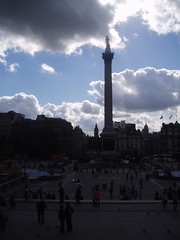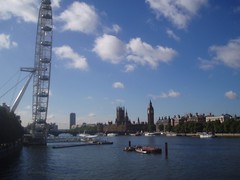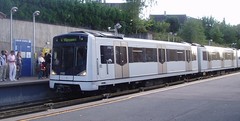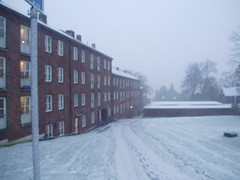October 1st thru October 7th 2006Sunday October 1st, 2006, both my mother and I arrived in
London . She had flown out the night before out of Minnesota and had arrived earlier in the day. I left Sogn around 2:00 PM and caught the T-Bane to Oslo Central Station and onward to a Flytoget to get to the airport. My flight was scheduled to leave at 6:25 PM and I was to arrive at Stansted Airport outside of London at 7:30 PM (1 hour time difference).
I was glad that I arrived early considering the queue at the Oslo Airport was quite long, however, I eventually made it to my correct gate and eventually my flight took off after about a half-hour of waiting, followed by a short bus ride to our plane and a quick walk from the bus and right onto the plane. A part of me felt like a celebrity, however, I realized then how cold it really was outside and wasn’t too happy about walking out to the plane vs. walking down a gantry.
I landed at Stansted at 8:00 PM, collected my luggage, and then made my way to catch a train from the
Stansted Express line to Liverpool station and onward to Marble Arch station near
Hyde Park home to the
Parkwood Hotel , our base of operations for the 5 days in London. The trains had other plans. That evening, the Stansted Express train was canceled between the airport and Liverpool Street Station for “Engineering Improvements”, where I needed to go. So instead of taking a train, I bought a ticket with a bus line called National Express and bought a ticket to Marble Arch in London.
I and what felt like hundreds of others, had to buy bus tickets as well, and spent a long time standing in the cold with all of our luggage waiting for the next available bus to wherever in London we needed to go. After about a half-hour I hoped on a bus that would take me to Victoria and Marble Arch. Riding on the bus for close to an hour it put me near Marble Arch around 11:00 PM, meaning that it took me close to 3 hours just to get from the airport to even the vicinity of the hotel. However, the fun didn’t stop there. Eventually I found the hotel simply by wandering and asking for help and it turns out I was rather close, but since it was a Sunday night the reception desk was closed and I had to ring the night bell once I found the place. Funny thing is, that my Mom heard my suitcase rolling down the street and my conversation with the night manager and greeted me as I came in.
Monday we woke up just in time for breakfast consisting of many cups of coffee, scrambled eggs, bacon, and sausage very British and very satisfying. We decided that for Monday our goal would be to tackle the overwhelming British Museum and then to see how we felt after that. My Mom has written an analysis of the museum which is not entirely a representation of Britain nor a museum but instead a display of the spoils from conquered countries from Colonialism that were once colonies of the vast British Empire. Most of these artifacts were stolen, bought, or acquired by other means. For example, the recent controversy over the Greek Statues from the Parthenon that are currently on display in the British Museum. I will post my Mother’s analysis after this one.
After the museum we ate at a local pub and had Fish and Chips and a brew. We also talked to a local Brit who had recently been to Minnesota visiting a friend, he recommend some activities for the rest of our stay. After lunch/dinner it started to rain, so we headed back to the hotel to grab a nap and talk about the British Museum. Later, we walked from the hotel along Hyde Park to Buckingham Palace and Queen Victoria’s Monument.
Tuesday, we had a very early start, waking up at 7:30 AM, and enjoying a good breakfast before heading out for another day of adventure. Our destination was the
London Eye followed by a trip to
Trafalgar Square home of the National Gallery, which we toured for a long time and got pretty burned out. After a coffee from the café at the square, we walked to Covent Garden to see the
London Transport Museum, however, the museum is currently closed until 2007. You can read more about the Museum
here:
Trafalger Square London

Post Card London

Disappointed over the closure of the museum, we stopped at the souvenir shop for the museum and picked up a few things including a Mind The Gap T-shirt for myself (which I wore today to class). However, I am a little worried that I should have gotten a XXL rather than a single XL considering how tight it felt when I put it on today :(
In regards to Public Transport, I was very impressed by the London Underground and glad to have the opportunity to ride and analyze the system. More on that in a later post that I will write hopefully soon.
The London Transport MuseumWith still some strength in us, we made the trip from Covent Garden to the next tourist trap: The
Tower of London. This contained most of the historical items we were hoping to see at the British Museum…Weapons from Medieval times including the collection of Henry the VIII’s armor, other royal armaments, and vast amounts of all kinds of instruments of combat. As one of the guides described to us “This was a fortress and a place of war, and still is today”, which is true, soldiers of the British Military still reside in the Tower of London as well as the Yeomen Wards who give great tours. Oh, as a side note the Crown Jewels are there as well!!!
We were both very impressed on how the Tower of London was laid out though in where we started and then where we ended, unlike the British Museum where you could start anywhere much to our frustration.
Completely wore out from our travels of the day, we hopped on the “Tube” back to Marble Arch and grabbed dinner at a Lebanese Restaurant and had a wonderful meal before relaxing and reflecting in the hotel before heading to bed ready to tackle the next day.
Wednesday, we woke up early again and enjoyed the full English breakfast routine provided by the hotel staff, which btw was very odd how they played techno or pop radio instead of the news in the morning, but oh well. The big breakfast paid off, because Wednesday was one of our longest in London. We spent a majority of the day (4 hours) at
Kew Gardens also known as the
Royal Botanical Gardens Kew meandering through the gardens, admiring trees, walking up Pagodas, watching old ladies being harassed by birds, and enjoying the gardens on a beautiful fall sunny day. Kew Gardens was probably one of the best places that we visited and definitely a stop I would make again.
After seeing Kew Gardens we enjoyed Burgers and a pint of beer at this restaurant outside of the Kew Station, which was really satisfying after four hours of walking around. When we got home we both took a very long nap and thought about the rest of the night. When I had landed, I met this older British Woman who helped me get to the hotel but also recommended a great and cheap Chinese restaurant called Wan Ku (I think), so we ventured to Soho and China Town looking for this restaurant and instead found
Lee Ho Fook’s from Warren Zevon’s Werewolves of London. We had to grab something to eat from there, however, we didn’t have a camera.
It started to get pretty crazy around that area of town when we started to leave and I think there were delays on the underground, so we were ready to head home and call it a night.
Thursday morning, we again had the full English breakfast and hiked to Leicester’s Square and searched for discount tickets to a show. We decided on
Guys and Dolls staring Patrick Swayze for Thursday evening. Having got the tickets we took the underground to Lambeth North Station and then walked to the
Imperial War Museum. This was an amazing museum with the main focus of war, mostly on Britain in World War I and World War II. One of the best pieces of the Museum was a section of the World War I and a recreation of what life would have been like battling in the Trenches that made World War I the war that the world would never forget. Another good recreation section was the blitz on London; however, it did not deliver or was as well thought out compared to the Trenches piece. The museum also possessed a great amount of military hardware including tanks from both WWI and WWII of both the Allied and Axis forces, artillery batteries, aircraft, and a very large inventory of things from all sectors of the world wars. Lastly, we walked through the Holocaust exhibit and then the exhibit on continued conflicts since the end of World War II.
After the museum, we grabbed some dinner at Navajo Joes’s, a restaurant recommended by Karena Johnson, who had worked in London over the summer. The food was pretty good and afterwards we walked to Piccadilly Circus and were able to eventually find the Piccadilly Theater where the performance was held. However, when we arrived, we found out that Patrick Swayze would not be performing that evening as a result of an injury. We were a little disappointed but still where excited to see a musical in London, especially a musical neither of us had seen. The play was great, however, we didn’t know who Patrick Swayze’s character was supposed to be so we quickly checked the website (which I have linked) when we got home and he was supposed to play the character Nick Detroit. What was funny was that we though that the person who played that character the night we saw the performance was perfect! Oh well.
Friday was another busy day of running around for our last full day in London. We started at the
London Museum, which chronicled London as an ever-changing area of human civilization all the way from ancient times to Modern times, and the challenges that London needed to face to become the Metropolis of 7 Million people that it is today. Probably another one of the places that was of high interest to me (being an Urban Studies Major) and a museum I’d like to tour again.
The rest of the day was spent touring two famous churches St. Paul’s Cathedral and the Temple Church of the Knight’s Templar. At St. Paul’s we climbed a lot of stairs to the top of the dome and I went even farther up to the stone gallery on the outside of the church but was greeted by the heavy London rain. After that, we descended down into one of the largest underground crypts in Europe and saw some famous tombs. The Temple Church we had to see since being fans of the great book
The Da Vinci Code that now more than half the world has read and seen as a major motion picture. Lastly, we visited the National Portrait Gallery and then called it a day.
For dinner, we enjoyed some delicious Italian food, however, the service was the slowest I have experienced so far in Europe. That night, I packed and went to bed early.
Saturday morning I was up at 5:30 AM, and out the door to catch a train to Liverpool Street Station and back to the Airport to get back to Oslo. Thus ended the semester break and the much-needed visit with my mom.
After this post, I plan on posting my Mom's review of the British Museum (as stated above) and then hopefully later on in the week writing a summary of some of the big events that have taken place here in Oslo over the course of the program.
Stay tuned for more updates from Oslo
Cheers!




